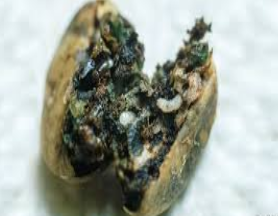Few pests wreak more havoc on coffee plantations than the berry-borer beetle.
咖啡浆果甲虫能对咖啡种植园造成很大破坏,很少有害虫能比它们更厉害。
In Brazil alone its depredations are reckoned to cost $300m a year,
仅在巴西,预计其造成的损失为每年三亿美元,
so keeping the insects under control is a priority for plantation owners around the world.
因此对全世界的种植园主而言,控制这些昆虫成为头等大事。
That is easier said than done. Berry borers spend most of their lives inside the berries.
说比做要容易。浆果蛀虫一生大部分时间都呆在浆果中。
Their eggs hatch there. Their larvae feed, grow and pupate there. And their adults mate there.
它们在那里孵卵。它们的幼虫在那里进食、生长和化蛹。成年后也在那里交配。
Only pregnant females seeking another berry to lay their eggs actually see the light of day. This makes attacking the beetles with insecticides tricky.
仅有怀孕的雌性会出来寻找另一颗浆果产卵,那时它们才真正见到了阳光。因此难以用杀虫剂对付它们。
Researchers have, however, known for some time that a species of Central American ant called Azteca sericeasur is adept at keeping berry-borer populations at bay.
但研究人员知道一种被称为Azteca sericeasur的中美洲蚂蚁很擅长牵制这种咖啡浆果蛀虫的数量。
害虫防治:弦理论(1).jpg
These ants live in trees grown alongside coffee bushes to provide shade—for coffee bushes do not thrive in direct sunlight.
这些蚂蚁住在树上,而这些树和咖啡灌木共同生长并为它们提供树荫,因为在阳光直射的地方咖啡灌木无法茁壮成长。
In particular, the ants prefer to nest in a tree called the cuaniquil.
这些蚂蚁尤其喜欢在一种被称为cuaniquil的树上筑巢。
The question is how to encourage Azteca's foraging workers down from their cuaniquil eyries
问题是如何能鼓励Azteca的觅食工从它们位于cuaniquil树上的巢穴中出来
and into coffee bushes in large enough numbers to keep berry borers under control.
并大批进入咖啡灌木中抑制这些浆果蛀虫。
And, as they report in Biotropica, Esteli Jimenez-Soto of the University of California, Santa Cruz,
并且正如他们在《Biotropica》期刊中所述,圣克鲁兹加利福尼亚大学的Esteli Jimenez-Soto
and Jonathan Morris of the University of Michigan think they have an answer: build bridges.
以及密歇根大学的Jonathan Morris认为他们有了一个答案:建立桥梁。
Working with a team of colleagues, Dr Jimenez-Soto and Dr Morris studied a coffee plantation in Chiapas, Mexico.
通过和同事合作,Jimenez-Soto博士和Morris博士对墨西哥恰帕斯的一个咖啡种植园进行了研究。
All of the coffee bushes there were growing under a canopy of shade trees, and some of these trees were cuaniquil.
所有咖啡灌木都在能遮荫的树下生长,并且其中一些树就是cuaniquil树。
The researchers selected 20 sites, each separated from the others by at least ten metres, for their experiment.
研究人员选择了20个地方用于实验,且每处相隔至少10米。
All included a cuaniquil that hosted an active ant colony and six coffee bushes that were not touching one another.
每一处都有一棵蚁群寄居的cuaniquil树以及六个互不干涉的咖啡灌木。
To the trunks of three of these bushes, selected at random, they tied strings that led to branches of the ant-bearing cuaniquil.
他们随机从这些灌木中选择了三支,并绑上了线以连接cuaniquil树的树干。
The other three bushes were left untouched and monitored as controls.
留下其他三处灌木以作为对照。
The team followed up by counting ants periodically on specific sections of the coffee bushes during the days that followed.
之后团队定期计算咖啡灌木中某一特定部分的蚂蚁数量
To decide whether the newly established string highways were indeed granting protection,
为了确定新建立的线高速确实提供了保护作用,
three days after building the connections Dr Jimenez-Soto and Dr Morris
在建立连接三天后,Jimenez-Soto博士和Morris博士
attached white cards bearing ten dead adult female borer beetles to the trunks of all the coffee bushes in the research sites.
将带有十只成年雌性死虫的白色卡片附在了所有被研究咖啡灌木的树枝上。
They monitored these cards for half an hour, noting ant activity on them, and also recording how many beetles were removed during that period.
他们对这些卡片进行了半小时监控,在此期间内,他们记录蚂蚁在此的活动,以及被移除甲虫的数量。
The string highways proved popular with the ants. Three-quarters of them turned into ant trails,
事实证明线高速很受蚂蚁的欢迎。三分之一的线高速都变成了蚂蚁的路径,
and at least some were used in this way in every one of the study sites.
并且在每个试验址中,至少有一些被以这种方式使用。
Presumably as a consequence, ant activity on bushes connected by strings to cuaniquil trees more than doubled,
大概率结果是,和cuaniquil树连接后,蚂蚁在灌木中的活动翻倍,
while that on unconnected neighbours saw no statistically significant change.
而未被连接的灌木在统计上没有明显变化。
This extra activity resulted in more beetle-scavenging.
这种额外的活动导致更多的甲虫被清除。
Coffee bushes connected by string to a cuaniquil had an average of three of the carded insects removed by the ants during the 30-minute window,
在30分钟时间内,用线将咖啡灌木和一棵cuaniquil树相连,平均有三只死虫被蚂蚁拖走,
triple the rate for unconnected bushes. Dead beetles on cards are clearly easier prey than live ones hidden in coffee berries.
是未连接灌木比率的三倍。卡片上的死甲虫显然比咖啡浆果中藏着的活虫更好捕食。
Nevertheless, this is an encouraging result for plantation owners.
然而,这对种植园主而言是个鼓舞人心的结果。
If further experiments back these results up
如果后续试验能够为这一结果提供支持,
it may be that the coffee-borer problem can be alleviated by a combination of planting the right sorts of shade trees and the wise deployment of some balls of string.
那么通过种植正确的遮荫树种并合理布局一些线球,咖啡蛀虫的问题就能得到缓解。
来源:经济学人

参与评论